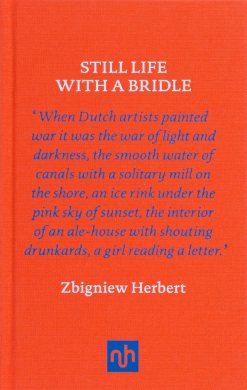So That the Soul Would not Be Distracted

A very astute reader of Sebald’s work sent me an email recently noting that the final sentence of The Rings of Saturn (1995) bears a striking resemblance to the final sentence of the Polish poet Zbigniew Herbert’s book Still Life with Bridle: Essays and Apocryphas (London: Jonathan Cape, 1993). What’s up with this, we both wondered?
Here’s Sebald:
And Sir Thomas Browne, who was the son of a silk merchant and may well have had an eye for these things, remarks in a passage of the Pseudodoxia Epidemica that I can no longer find that in Holland of his time it was customary, in a home where there had been a death, to drape black mourning ribbons over all the mirrors and all canvasses depicting landscapes or people or the fruits of the fields, so that the soul, as if left the body, would not be distracted on its final journey, either by a reflection of itself or by a last glimpse of the land now being lost for ever.
Here’s Herbert. describing how a family prepares for the departure of the soul of a recently deceased Dutch merchant in the seventeenth century:
Then they would cover all the mirrors in the house, and turn all the pictures to the walls so the image of a girl writing a letter, of ships in open sea, of peasants dancing under a tall oak, would not stop the one who wanders toward unimaginable worlds from going on his way.
It would not be surprising at all that Sebald might insist that Browne is the source for this paraphrased quote rather than Herbert, for he used Browne as a source and a handy foil throughout The Rings of Saturn and it would make sense that the closing statement be shoehorned so that it appear to come from Browne. But had Sebald read Herbert? And might he have lifted from him the idea of be-ribboning mirrors and turning canvasses to the wall so that the spirits of the dead would not be distracted on their passage?
We know that Sebald read Still Life with Bridle. In an interview Sebald did with then Los Angeles Times Book Editor Steve Wasserman at the Los Angeles Public Library in 2001, Sebald recounts having disliked Herbert’s book when he read it first in English but then loving it when he read it in French. (I had earlier written said that it was not known if Sebald read Herbert’s book, but a Vertigo reader kindly pointed out that the point is settled on p. 372 of Saturn’s Moons.*) Still Life with Bridle is primarily about Dutch art of the seventeenth century, a subject that Sebald addresses several times in The Rings of Saturn, most notably in his discussion of Rembrandt’s painting The Anatomy Lesson (1632). The quote we have been looking at from Herbert is the last sentence in “Epilogue,” the final of ten short “Apocryphas,” pieces in which he freely mixes up fact and fiction to tell brief stories that often include real historical characters, such as Rembrandt and Vermeer. When Herbert’s book first came out, Matthew Stadler, writing in the New Times Book Review, was troubled about “this untraceable blurring of fact and fiction” in the Apocryphas, but this is exactly what Sebald would have loved about them. It’s easy to see why Sebald would have been attracted to Herbert’s description of the departure of the dead soul.
Curiously, when The Rings of Saturn was initially reviewed in the New York Times on July 26, 1998, Roberta Silman wrote in her opening sentence:
This is a hybrid of a book — fiction, travel, biography, myth, and memoir — that obliterates time and defies comparison. Stunning and strange, it may remind you of Zbigniew Herbert’s Still Life With a Bridle or Nabokov’s Speak, Memory, or the work of Italo Calvino, Walter Benjamin or even Jonathan Swift, yet by the end you know it is like none of these.
Silman picked out Herbert’s book for other reasons, but now it seems prescient for this other linkage between the two authors.
Herbert’s book was reissued in 2012 by the terrific Notting Hill Editions. Translated by John and Bogdana Carpenter.
*Jo Catling. Saturn’s Moons: A W.G Sebald Handbook. Routledge, 2019.
